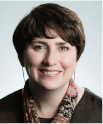Post-stack 3D merging to fast-track regional interpretation – offshore Otway Basin case study
Merrie-Ellen Gunning A * , Scott Wilkinson B , Pei-Fei Chau B , Cameron Mitchell A and Jennifer Badry BA
B

Merrie-Ellen Gunning has an MBA and a Bachelor of Applied Science in Geology, having studied at Melbourne Business School and RMIT University. She has over three decades of industry experience. Since joining Geoscience Australia in 2015, she has worked on a wide range of prospectivity and CCS projects and is currently Director – Offshore Energy Systems. |

Scott Wilkinson has over 30 years of processing and acquisition experience working for a range of geophysical companies, predominantly in the UK and Australia. He is currently a Geoscience Team Manager at DUG Technology in Perth. Scott graduated from John Moores University with a BSc in geology and is a member of PESA. |

Pei Fei Chau is a Geophysicist at DUG Technology Australia. Since graduating in 2011, she has worked with CGG and DUG Technology in Malaysia and Australia. Her experience includes 2D and 3D marine processing (time and depth) across offshore Asia-Pacific. She has a Bachelor’s Degree in Applied Physics, from the University of Science, Malaysia graduating in 2011. |

Cameron Mitchell is a technical geoscientist at Geoscience Australia. His recent focus has been modernisation of workflows and technology. He has worked on regional tectonostratigraphic, prospectivity and CCS studies, seismic survey planning, and was the Chief Scientist of the 2007 Great Australian Bight sampling survey. Cameron has a BSc (Hons) in geology from the Australian National University from 2000. |

Jennifer Badry is a Senior Support geophysicist at DUG Technology, focussing on Full Waveform Inversion. Previously, Jennifer was a senior geophysicist working in processing and imaging. Jennifer holds a Bachelor of Science in geophysics, from the University of Alberta, and has 16 years of industry experience in seismic processing and imaging around the world. |
Abstract
Ideally when combining legacy 3D seismic surveys, differences in acquisition parameters warrant full pre-stack reprocessing from field data. However, there are occasions where this is not possible due to time, financial or data access constraints; a valuable alternative is post-stack merging and enhancement of existing migrations. This case was to produce a regularised and seamless 3D dataset of the highest possible quality, for the offshore Otway Basin, within 2 months. The input migrated volumes varied by data extent, migration methodology, angle range and grid orientation. Fourteen input volumes totalling 8092 km2 were post-stack merged and processed to produce a continuous and consistent volume, enabling more efficient and effective interpretation of the region. The surveys were regularised onto a common grid, optimised for structural trends, prior to survey matching. A mis-tie analysis algorithm, applied over a time window optimised for interpretation of key events, was used to derive corrections for timing, phase and amplitude, using a reference. This was followed by time-variant spectral and amplitude matching to improve continuity between volumes. Additional enhancements including noise removal and lateral amplitude scaling were also applied. The final merged volume offers significant uplift over the inputs, providing better imaging of structure and events and dramatically improving the efficiency and quality of interpretation. This enables rapid reconnaissance of the area by explorers.
Keywords: 3D seismic, marine seismic, Otway Basin, post-stack merge, reprocessing.
 Merrie-Ellen Gunning has an MBA and a Bachelor of Applied Science in Geology, having studied at Melbourne Business School and RMIT University. She has over three decades of industry experience. Since joining Geoscience Australia in 2015, she has worked on a wide range of prospectivity and CCS projects and is currently Director – Offshore Energy Systems. |
 Scott Wilkinson has over 30 years of processing and acquisition experience working for a range of geophysical companies, predominantly in the UK and Australia. He is currently a Geoscience Team Manager at DUG Technology in Perth. Scott graduated from John Moores University with a BSc in geology and is a member of PESA. |
 Pei Fei Chau is a Geophysicist at DUG Technology Australia. Since graduating in 2011, she has worked with CGG and DUG Technology in Malaysia and Australia. Her experience includes 2D and 3D marine processing (time and depth) across offshore Asia-Pacific. She has a Bachelor’s Degree in Applied Physics, from the University of Science, Malaysia graduating in 2011. |
 Cameron Mitchell is a technical geoscientist at Geoscience Australia. His recent focus has been modernisation of workflows and technology. He has worked on regional tectonostratigraphic, prospectivity and CCS studies, seismic survey planning, and was the Chief Scientist of the 2007 Great Australian Bight sampling survey. Cameron has a BSc (Hons) in geology from the Australian National University from 2000. |
 Jennifer Badry is a Senior Support geophysicist at DUG Technology, focussing on Full Waveform Inversion. Previously, Jennifer was a senior geophysicist working in processing and imaging. Jennifer holds a Bachelor of Science in geophysics, from the University of Alberta, and has 16 years of industry experience in seismic processing and imaging around the world. |
References
Abbott S, Bernardel G, Nicholson C (2022) Offshore Otway Basin: Surface grids, isochore grids, and fault maps. Geoscience Australia, Canberra. doi:10.26186/146398
Abbott S, Cubitt C, Bernardel G, Nicholson C, Nguyen D (2023) Towards a regional understanding of Sherbrook Supersequence gross depositional environments, offshore Otway Basin. In ‘4th Australasian Exploration Geoscience Conference’, 2023, Brisbane. https://doi.org/10.5281/zenodo.7980133
Barlass D, Hamilton R, Mehay S, Parent A, Pei I, Schenk O, Gunning M, Vonk A (2024) Building a carbon dioxide storage portfolio for the Barrow-Dampier sub-basins through regional screening – an integrated geoscience approach. Australian Energy Producers Journal 64, S314-S319.
| Crossref | Google Scholar |
Cadzow JA (1988) Signal enhancement-a composite property mapping algorithm. IEEE Transactions on Acoustics, Speech, and Signal Processing 36, 49-62.
| Crossref | Google Scholar |
Nicholson C, Abbott S, Bernardel G, Poudjom Djomani Y (2024) A new perspective on regional structural architecture across the offshore Otway Basin. Australian Energy Producers Journal 64, S416-S422.
| Crossref | Google Scholar |


